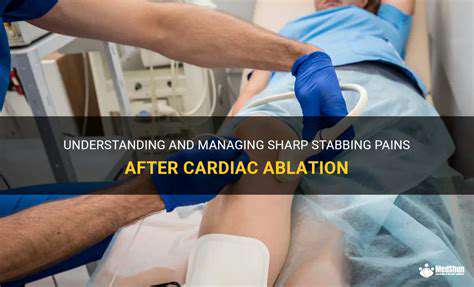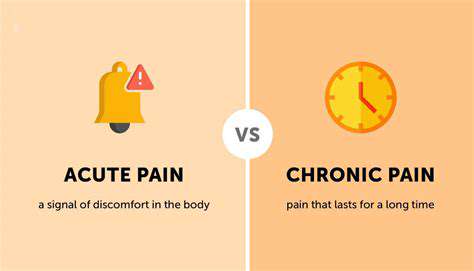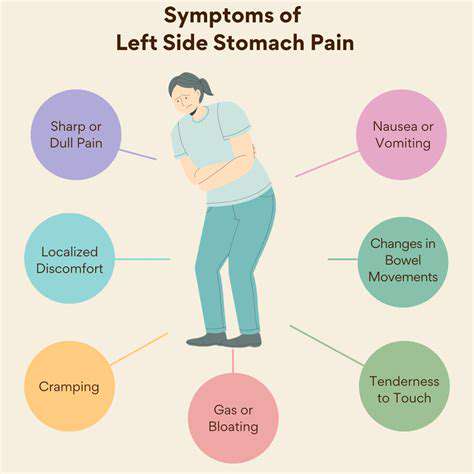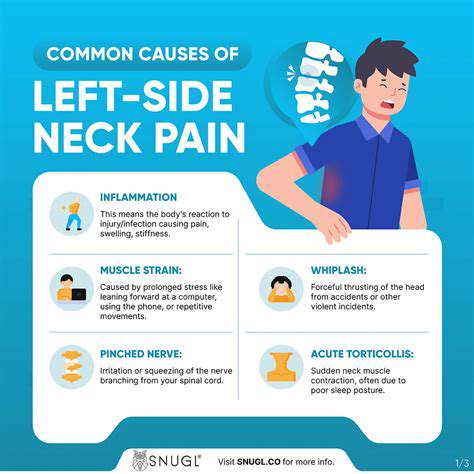Distinguishing Pain: The Stabbing vs. Dull Throbbing Experience
Understanding Sharp, Stabbing Pain

Causes of Sharp, Stabbing Pain
Sharp, stabbing pain can arise from a multitude of medical conditions, each with its own unique characteristics and implications. Identifying the cause of this pain is essential for determining the appropriate treatment plan. For instance, issues related to the gastrointestinal tract, such as gallstones or appendicitis, often produce acute discomfort that can manifest as sudden, sharply localized feelings.
Additionally, sharp pain may also be attributed to nerve-related conditions like sciatica or neuropathy, which can create sensations that feel overly intense and debilitating. Recognizing the specific location and nature of the pain can significantly aid healthcare providers in pinpointing the underlying issue. Furthermore, injuries like fractures or sprains in muscles or tendons can lead to sudden and localized pain, demanding immediate assessment and care.
Differences Between Sharp and Dull Throbbing Pain
Sharp, stabbing pain usually presents itself suddenly and is often momentary, while dull throbbing pain is more persistent and may intensify gradually over time. Understanding this difference can help individuals better communicate their symptoms to healthcare professionals. Sharp pain is typically associated with acute injury or a specific condition, whereas dull throbbing pain can often indicate chronic issues such as arthritis or tension headaches.
Furthermore, the two types of pain evoke different emotional responses and can affect day-to-day activities in various ways. For example, patients experiencing sharp pain may seek immediate medical attention, whereas those with dull throbbing pain might tolerate it for a more extended period before seeking help. Catching these distinctions early on is crucial for effective pain management and treatment strategies.
The Nature of Dull, Throbbing Discomfort
Understanding Dull Pain
Dull pain is often described as a persistent sensation that feels deep and unfocused rather than sharp and acute. This type of discomfort can be a result of various underlying conditions, such as muscle tension or inflammation, and may fluctuate in intensity. Unlike stabbing pain, which tends to appear suddenly, dull pain often builds gradually and can linger for extended periods, making it particularly challenging to ignore.
One common area where dull pain manifests is in the lower back, where poor posture or prolonged sitting can lead to muscle fatigue and strain. Individuals experiencing this type of pain might find that certain movements exacerbate their symptoms while others provide temporary relief. Understanding the triggers is critical for managing and alleviating the discomfort effectively.
Dull pain can also be indicative of chronic conditions like fibromyalgia or arthritis. For those suffering from these afflictions, the continual dull ache may be a reminder of their condition, leading to emotional distress and impacting their daily activities. Recognizing and addressing the sources of this pain is vital for improving quality of life and fostering a proactive approach to health.
Throbbing Discomfort and Its Implications
Throbbing discomfort is characterized by a rhythmic sensation that pulses in time with the heartbeat. This type of pain often suggests an underlying issue, such as arterial or venous problems, headaches, or migraines. The cyclical nature of throbbing pain can be particularly distressing, making it feel like an insistent presence that can detract from one’s ability to concentrate or engage fully in daily life.
This throbbing sensation can also indicate inflammation in certain areas of the body, signaling that the body's immune response is active. For example, in the case of a tooth abscess or an injury, the throbbing pain can signal the body’s efforts to heal. Recognizing the connection between throbbing discomfort and inflammation can guide individuals to seek appropriate medical intervention.
Moreover, it’s essential to consider the psychological impact of chronic throbbing discomfort. The persistent nature of such pain can lead to anxiety, depression, or a decline in overall well-being. Patients are often encouraged to discuss these elements with healthcare professionals as part of a comprehensive pain management plan that addresses not just the physical but also the emotional dimensions of pain.
Distinguishing Between Stabbing and Dull Throbbing Pain
When evaluating the types of pain experienced, distinguishing between stabbing and dull throbbing pain is crucial for diagnosis and treatment. Stabbing pain is often isolated in nature, creating an urgent need to address its underlying cause, while dull throbbing pain tends to be more diffuse and chronic. This difference not only influences the perceived severity but also guides the approach to treatment.
In clinical settings, understanding these distinctions helps healthcare providers determine the appropriate diagnostic tests and interventions. For instance, while nerve-related issues may contribute to stabbing pain, muscular or postural problems often correlate with dull aches. Consequently, treatment plans can be tailored to the specific characteristics of the pain experienced by the patient.
Moreover, personal coping strategies may differ based on the pain's nature. Individuals need to identify when immediate intervention is necessary for stabbing pain, while dull throbbing pain may encourage lifestyle modifications, stress management techniques, and long-term care strategies. Ultimately, recognizing the nuances between these pain types can empower individuals to seek effective, individualized care.
Seeking Relief and Management Strategies
Finding relief from dull, throbbing discomfort involves a multi-faceted approach targeting both symptoms and root causes. Over-the-counter pain relievers like ibuprofen can temporarily alleviate discomfort, but for chronic conditions, a more comprehensive care plan may be necessary. Consulting with a healthcare provider can help in determining a suitable course of action, which may include physical therapy, exercise, or alternative treatments.
In addition to medical intervention, lifestyle modifications play a vital role in managing dull and throbbing pain. Regular physical activity, yoga, and stretching can enhance mobility and reduce muscle tension, while stress management techniques like meditation or deep breathing exercises can help mitigate the discomfort associated with chronic pain. Nutrition also contributes to overall health, and adopting an inflammation-reducing diet can provide long-term benefits.
Moreover, establishing a strong support system can be beneficial for individuals battling chronic pain. Sharing experiences with others in similar situations, attending support groups, or even engaging in counseling can foster emotional resilience and provide practical coping strategies. Empowering oneself with knowledge about pain management options can lead to more effective self-care practices and a better overall quality of life.
Comparing the Two Types of Pain

Understanding Stabbing Pain
Stabbing pain is often characterized by its sudden onset and sharp intensity. Many individuals describe this type of pain as a feeling like being pierced with a knife, making it both alarming and distressing. It can arise from various conditions, each warranting different approaches for relief and treatment. Understanding the underlying causes is essential for effective management.
This sharp pain can be localized or radiate through different areas of the body. For instance, stabbing pain in the chest could indicate serious conditions, such as angina or a pulmonary issue. In contrast, stabbing pain in the abdomen might suggest gastrointestinal problems or issues such as appendicitis. Recognizing the location and nature of the stabbing pain can guide healthcare providers in diagnosing the issue.
Emotional factors such as anxiety can also exacerbate the perception of stabbing pain, adding a psychological layer to the physical sensation. It's important to consider both physical and mental health when evaluating this type of pain. Many individuals find that stress management techniques can help alleviate their symptoms, demonstrating the body-mind connection.
When it comes to treatment, pain relief options vary widely. Medications such as NSAIDs may provide temporary relief, but addressing the root cause should be the primary focus. In some cases, physical therapy, counseling, or even surgical interventions could become necessary depending on the diagnosis.
Exploring Dull Throbbing Pain
Dull throbbing pain often presents as a persistent, aching sensation that can vary in intensity. Unlike stabbing pain, this type typically emerges gradually and may last for extended periods, making it a chronic source of discomfort for many individuals. Understanding its nature is crucial to managing it effectively.
This type of pain can also be associated with a number of conditions, including migraines, arthritis, or chronic fatigue syndrome. Many people describe it as a constant pressure within their body that can create fatigue or irritability. Recognizing the specific medical conditions associated with dull throbbing pain can significantly aid in formulating an effective treatment plan.
Additionally, dull throbbing pain can often fluctuate in severity throughout the day. Some individuals report that stress, lack of sleep, or poor posture can worsen this type of pain, making lifestyle changes an essential component of management. Strategies such as regular exercise, ergonomic adjustments, and mindfulness practices have shown promise in alleviating symptoms.
Unlike stabbing pain, treatment options for dull throbbing pain often focus on long-term management rather than immediate relief. Patients may benefit from physical therapy, acupuncture, or lifestyle modifications that promote overall well-being. Addressing these underlying factors is critical for reducing the frequency and intensity of pain episodes.
Contrasting the Two Pain Types
When comparing stabbing and dull throbbing pain, it's essential to note their distinct characteristics. Stabbing pain is typically acute, intense, and often sharp, making it alarmingly noticeable. In contrast, dull throbbing pain presents itself as a persistent, less intense ache that can quietly disrupt daily activities. Understanding the differences between these two types of pain can enhance diagnostic accuracy and treatment efficacy.
Moreover, the emotional response to these pains can differ significantly. Stabbing pain may induce immediate panic or concern due to its sharpness and sudden appearance, while dull throbbing pain might lead to a gradual accumulation of frustration over time. This emotional component is crucial for clinicians to consider when developing treatment plans.
The effectiveness of pain management strategies also varies significantly between these two types. Stabbing pain often requires rapid intervention, possibly including analgesics or other acute care treatments. In contrast, dull throbbing pain may necessitate a broader range of management options, including lifestyle changes and long-term therapies.
The experience of these pains can impact an individual's quality of life and their ability to engage in daily activities. It's vital for patients to communicate openly with healthcare providers about their pain experiences. This dialogue allows for tailored approaches that address not just the physical discomfort but also the emotional and psychological impacts.
Seeking Appropriate Medical Attention
When dealing with either stabbing or dull throbbing pain, it is imperative to seek medical advice, particularly if symptoms persist. Medical professionals can conduct necessary evaluations to identify the root causes and determine the best course of treatment. Early diagnosis can significantly influence outcomes and ease the path to recovery.
Patients should be prepared to share detailed descriptions of their pain, including its location, intensity, and triggers. Documenting these details can immensely assist healthcare providers in making informed decisions regarding diagnosis and management. Creating a pain diary could be beneficial for individuals struggling to articulate their experiences.
Furthermore, individuals experiencing sudden and severe stabbing pain should consider it a medical emergency. Conditions such as heart attacks, organ ruptures, or fractures require prompt attention to prevent further complications. On the other hand, persistent dull throbbing pain, while often less urgent, should still be evaluated over time to ensure no underlying serious issues develop.
In conclusion, whether one is experiencing stabbing or dull throbbing pain, understanding the specifics of each type is essential for effective management. Appropriate medical attention and open communication with healthcare providers can lead to tailored treatment strategies that address both the physical and psychological aspects of pain.




